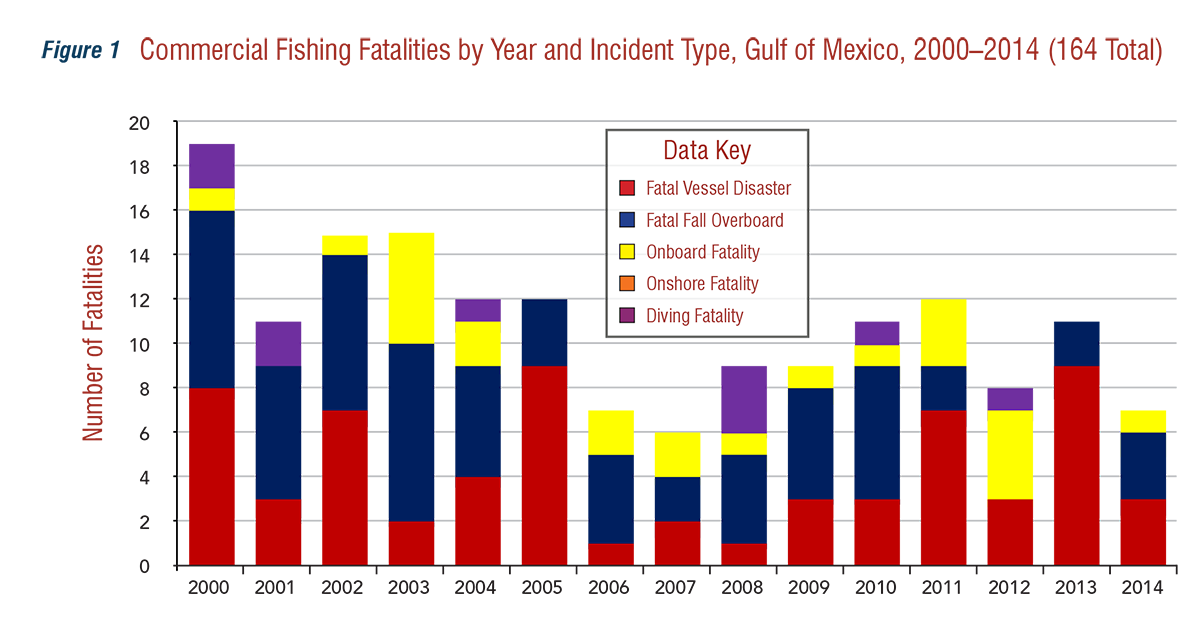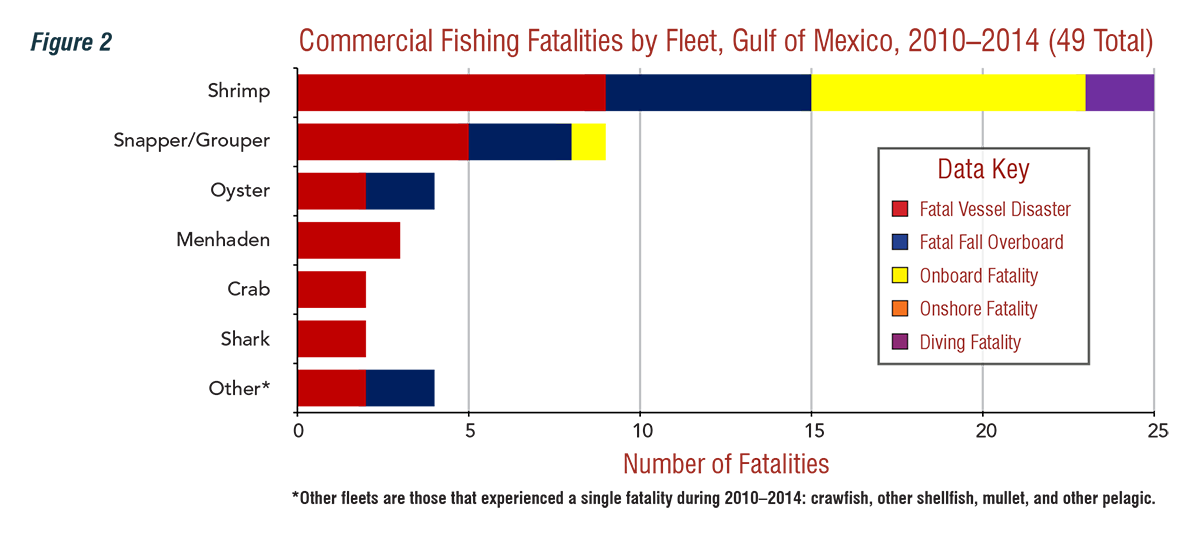COMMERCIAL FISHING SAFETY
Commercial Fishing Safety in the Gulf of Mexico

During the 15-year period 2000–2014, 164 commercial fishing deaths due to traumatic injury occurred in Gulf of Mexico fisheries, averaging almost 11 fatalities annually (Figure 1). During the first decade (2000–2009), 115 fatalities occurred, for an average of nearly 12 deaths per year. For the most recent five-year period (2010–2014), 49 fatalities were recorded, averaging 10 fatalities annually. During 2000–2009, the leading cause of fatalities in the region was falling overboard; however, during 2010–2014, the leading cause of fatalities was vessel disasters.

Gulf of Mexico Leading Hazards and Recommendations
Vessel Disasters
Vessel disasters are sinkings, capsizings, groundings, fires, or other events that force crews to abandon ship. Vessel disasters accounted for half of all fatalities (25, 51%) in the Gulf of Mexico during 2010–2014. The leading causes of fatal vessel disasters were collisions and allisions (striking a stationary object), flooding, and instability.
Recommendations:
- Take a marine safety class at least every five years.
- Conduct monthly drills for abandon ship, fire, and flooding.
- Ensure watertight integrity of the vessel.
- Perform maintenance activities to prevent fires and explosions.
Falls Overboard
During 2010–2014, 13 crewmembers died from drowning after falling overboard, contributing to 27% of fatalities in the region. None of the crewmembers were wearing a personal flotation device (PFD) when they drowned. Over half (54%) of the falls were not witnessed by other crewmembers, either because the fishermen were alone on the vessel (1) or alone on deck (6). Fatal falls overboard were most frequently caused by losing balance or by contact with gear, including being knocked over by or becoming entangled in gear.
Recommendations:
- Wear a PFD on deck.
- Utilize a man overboard alarm system.
- Add effective recovery devices and re-boarding ladders.
- Conduct monthly man-overboard drills.
Onboard Fatalities
Of the fatal onboard injuries (9, 18%), the majority involved contact with equipment: four deaths from being caught in winches, and two deaths from being struck by a hook and by a pulley. The remaining three onboard fatalities were due to a drug overdose and two instances of assault. There are engineering controls available which can help reduce the chance of being caught in a winch
Recommendations:
- Install safety devices on deck machinery.
Gulf of Mexico Fishing Fatalities by Fleet

Fatalities occurred in 10 fleets in the Gulf of Mexico, with six fleets experiencing two or more fatalities (Figure 2).
Shrimp
The shrimp fleet had the highest number of fatalities in the Gulf of Mexico, with 25 deaths. These fatalities constituted half of all deaths in the region during 2010–2014. Among shrimp fishermen, the leading causes of death were vessel disasters, onboard injuries, and falls overboard. NIOSH recommends wearing a PFD on deck at all times. Also, there are engineering controls available which can help reduce the chance of entanglement in winches, and NIOSH is currently testing new versions of winch guards on shrimp boats in the Gulf of Mexico.
Snapper/Grouper
The second highest number of fatalities occurred in the snapper/grouper fishery, with six deaths caused by vessel disasters, three deaths caused by falls overboard, and one death caused by an onboard injury.
Want to know more?
For more statistical information and detailed recommendations on how to keep you and your fellow crewmembers safe, open or download the full regional summary: Commercial Fishing Fatality Summary – Gulf of Mexico Region (2010-2014)
For more information about other regions, visit our Alaska, West Coast, and East Coast regional summary pages.
- Page last reviewed: June 8, 2015
- Page last updated: June 8, 2015
- Content source:
- National Institute for Occupational Safety and Health Office of the Director


 ShareCompartir
ShareCompartir